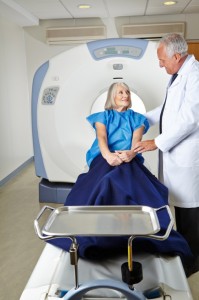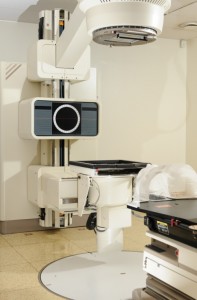10 Years of Use Proves the Safety and Efficacy of SBRT for Lung Cancer
 According to researchers from the Cleveland Clinic Foundation, a decade of lung cancer treatment with SBRT has proven that this focused radiation therapy is not only effective for controlling the growth and spread of lung cancer, it can also limit radiation exposure for the patient. The researchers tracked the results of SBRT for inoperable, early-stage lung cancer from 2003 to 2013. During that time, a mere 13 percent of the patients studied demonstrated any side effects, and even among those that did, symptoms were usually minimal.
According to researchers from the Cleveland Clinic Foundation, a decade of lung cancer treatment with SBRT has proven that this focused radiation therapy is not only effective for controlling the growth and spread of lung cancer, it can also limit radiation exposure for the patient. The researchers tracked the results of SBRT for inoperable, early-stage lung cancer from 2003 to 2013. During that time, a mere 13 percent of the patients studied demonstrated any side effects, and even among those that did, symptoms were usually minimal.
50-in-5 Regimen
For the purposes of the study, patients received what the researchers dubbed the “50-in-5 regimen” of SBRT, which consists of a total of 50 Gy of focused radiation delivered over the course of five sessions. Between October 2003 and December 2012, 300 patients received the 50-in-5 regimen to treat a total of 340 non-small cell lung cancer lesions. The average patient was 74 years old and over half the patients studied were women. A little more than 18 percent were cigarette smokers, although most of the patients were considered inoperable for other reasons.
The majority of the patients only needed a single course of SBRT for lung cancer treatment. Treatments were administered daily over a five-day period. Fifteen percent of the patients needed one or more additional courses of SBRT because their cancer came back. The short course of treatment with SBRT and the effectiveness of the treatment are why so many patients now choose CyberKnife for non-invasive lung cancer treatment.
 High Efficacy, Low Toxicity
High Efficacy, Low Toxicity
Though researchers did find that SBRT was effective at treating non-small cell lung cancer, they did point out that only 47 percent of the patients were alive at the five-year follow-up, largely due to patients’ advanced age and the occurrence of other diseases that affect survival. While SBRT did eliminate the cancer within the lung, a significant percentage of patients experienced a return of cancer in another part of the body.
Nevertheless, Cleveland Clinic Foundation radiation oncologist Dr. Gregory Videtic called the treatment “an amazing technology for a population of patients who previously had no other options.” He believes that this non-invasive, focused radiation treatment could extend the life spans of up to 20,000 people each year by giving those who aren’t healthy enough for surgery another option.
Furthermore, SBRT is one of the safest forms of cancer treatment. A mere 13 percent of the patients studied exhibited any side effects at all due to the treatment, and all of those were low-level, minor side effects. In 75 percent to 80 percent of the cases, side effects were minor enough to heal on their own, and within a short time frame. Previous studies seemed to suggest that SBRT was very safe, but this study is important because side effects from radiation treatment can sometimes appear several years after treatment ends. The length of the study period allowed the researchers to evaluate the long-term safety of the procedure.
According to the results of a new 10-year study from the Cleveland Clinic Foundation, SBRT is effective and remains safe, even in the long term. If you or someone you love is suffering from inoperable lung cancer, this non-invasive procedure could help you overcome cancer with just one short round of treatment.
More
5 Trigeminal Neuralgia Surgeries Compared
 Trigeminal neuralgia pain most often occurs when a blood vessel compresses the trigeminal nerve near the bottom of the brain. The resulting malfunction causes pain to shoot through the teeth, jaw, cheek, gums, lips, eye, or forehead on one side of the face. While episodes may be mild and brief, they are known to become more frequent and more severe with time.
Trigeminal neuralgia pain most often occurs when a blood vessel compresses the trigeminal nerve near the bottom of the brain. The resulting malfunction causes pain to shoot through the teeth, jaw, cheek, gums, lips, eye, or forehead on one side of the face. While episodes may be mild and brief, they are known to become more frequent and more severe with time.
Medications may be used to relieve the symptoms of trigeminal neuralgia, but they can come with side effects that include double vision, nausea, dizziness, confusion, or drowsiness. Even if you don’t experience side effects, medications may lose their effectiveness eventually. Fortunately, there are multiple surgical options you can choose to permanently reduce or eliminate trigeminal neuralgia.
1. Radiosurgery With CyberKnife
CyberKnife radiosurgery for trigeminal neuralgia pain delivers focused radiation to the trigeminal nerve, damaging it and reducing or altogether, eliminating its ability to malfunction and cause pain. The procedure is one of the least invasive surgeries for trigeminal neuralgia pain, and, unlike some other procedures, it can be repeated if necessary. That’s important, because trigeminal neuralgia pain can return after surgery. CyberKnife for trigeminal neuralgia is gaining popularity because it’s an effective, non-invasive treatment that requires no incisions. More trigeminal neuralgia sufferers than ever are using radiosurgery with CyberKnife to relieve symptoms.
2. Microvascular Decompression
In this more invasive procedure, a surgeon makes a small incision near the base of the trigeminal nerve and then opens up your skull in order to physically move aside any blood vessels that may be compressing the nerve. It may be necessary to ensure that the blood vessels don’t come back into contact with the nerve by separating them from the trigeminal nerve with a small implant. It may also be necessary to remove a vein or sever the trigeminal nerve itself. Though microvascular decompression is usually successful, it carries risks, including:
- Facial numbness
- Hearing loss
- Double vision
- Facial weakness
- Stroke
3. Balloon Compression
In this procedure, the surgeon uses a hollow needle and catheter to insert a balloon near your trigeminal nerve where it protrudes from the base of your skull. Once the balloon is inflated, it causes enough damage to the nerve to stop the pain signals it sends. Like other invasive procedures for trigeminal neuralgia, balloon compression can cause facial numbness. You may also experience weakness in the jaw, which can be permanent.
 4. Glycerol Injection
4. Glycerol Injection
A glycerol injection for trigeminal neuralgia pain involves inserting a needle through the face and into the skull where the trigeminal nerve passes through it. Once the needle is inserted, your doctor will inject sterile glycerol in order to damage the trigeminal nerve and relieve any pain. The pain can return, however, and numbness of the face or tingling can occur.
5. Radiofrequency Thermal Lesioning
For the first part of this procedure, you’ll be sedated as your doctor guides a hollow needle into the opening through which your trigeminal nerve emerges from your skull. He or she will insert an electrode through the needle and administer an electric current. Your doctor will then bring you out of sedation so you can identify when and where the electric current causes a tingling sensation. The information you give will help the doctor determine which specific nerve fibers to damage in order to eliminate your symptoms. You may need to repeat the procedure and there may be some facial numbness afterward, but it usually isn’t permanent.
If you’re thinking of getting surgery for trigeminal neuralgia pain, you need to know all your options. Many of the procedures carry risks, just like any surgery. But with CyberKnife, you can experience non-surgical relief of trigeminal neuralgia pain with minimal recovery time and fewer side effects.
More
How Does SBRT Cyberknife Compare to Traditional Radiotherapy?
 Cyberknife is a form of targeted radiation therapy known as SBRT. SBRT, or stereotactic body radiation therapy, was adapted from central nervous system stereotactic radiosurgery, a treatment technique that has been used to treat tumors of the brain and central nervous system for over 30 years. The only real difference is that SBRT is used to treat tumors throughout the rest of the body instead of specifically in the brain.
Cyberknife is a form of targeted radiation therapy known as SBRT. SBRT, or stereotactic body radiation therapy, was adapted from central nervous system stereotactic radiosurgery, a treatment technique that has been used to treat tumors of the brain and central nervous system for over 30 years. The only real difference is that SBRT is used to treat tumors throughout the rest of the body instead of specifically in the brain.
How does SBRT compare to traditional radiation therapy? SBRT delivers radiation directly to the cancerous tissue, sparing the healthy tissue around it. As a result, it can be administered in fewer sessions, with fewer side effects, and with higher success rates.
How Cyberknife Works
If your doctor has recommended Cyberknife to treat your cancer, you may be wondering, “What is Cyberknife?” After all, it’s only recently that Cyberknife and other SBRT treatments have become popular for the treatment of tumors outside of the brain. Cyberknife delivers a highly targeted dose of radiation that kills cancerous tissue as effectively as surgery. So if you’re not a candidate for surgery, you may be a candidate for Cyberknife SBRT.
SBRT Administers More Radiation Than Traditional Radiotherapy
Because it delivers radiation directly to the cancerous tumor while minimizing radiation exposure to healthy tissue, SBRT uses a much stronger dose of radiation than traditional radiotherapy. Traditional radiation therapy delivers two to seven beams of radiation, while SBRT delivers over 100 beams of radiation from a much higher number of angles. That means SBRT is much more powerful.
With conventional radiotherapy, it’s not possible to aim the radiation beams directly at the cancerous tissue — that’s why so much less radiation is used, to minimize the damage to healthy tissue. Because SBRT allows doctors to administer a much more potent dose of radiation, far fewer sessions are necessary. Traditional radiotherapy requires daily sessions for several weeks. SBRT requires only one to five sessions.
 Cyberknife Is More Accurate Than Traditional Radiation Therapy
Cyberknife Is More Accurate Than Traditional Radiation Therapy
Because it’s able to target diseased tissue, Cyberknife SBRT is much more accurate than traditional radiation therapy. SBRT can deliver radiation to a margin of one to five millimeters surrounding a tumor. Conventional radiotherapy has a radiation delivery margin of 20 to 30 millimeters. This much wider margin means that conventional radiotherapy is more likely to cause healthy tissue damage and side effects like radiation pneumonia. With SBRT, the most common side effect is mild fatigue following treatment.
SBRT Is as Effective as Surgery
Not all tumors can be surgically removed. That’s why SBRT has long been used to treat tumors of the brain and central nervous system — these tumors are more difficult for surgeons to reach. Even when surgery is an option, it requires the removal of a margin of healthy tissue around the cancerous tissue. SBRT is just as effective as surgery for removing cancerous tissue from the body, but eliminates the need to remove healthy tissue.
When compared to conventional radiation therapy, SBRT is much more effective. Traditional radiotherapy is effective about 50 percent of the time. SBRT, on the other hand, is effective at controlling cancer more than 90 percent of the time.
If you’re not a good candidate for cancer surgery or simply want a less invasive treatment option, consider Cyberknife SBRT. With SBRT, doctors can administer potent, targeted radiation therapy that kills your cancer without harming the rest of your body. Find out what SBRT can do for you.
More
Don’t Let Depression Sabotage Your Breast Cancer Treatment
 Between 9 and 25 percent of women with breast cancer will also be diagnosed with depression. Even according to the most conservative estimates, women with breast cancer are twice as likely as the general population to be diagnosed with depression. And that’s a big deal, because depression is more than just an emotional phenomenon — it causes physiological symptoms that can make breast cancer harder to treat, and significantly raise your rate of recurrence.
Between 9 and 25 percent of women with breast cancer will also be diagnosed with depression. Even according to the most conservative estimates, women with breast cancer are twice as likely as the general population to be diagnosed with depression. And that’s a big deal, because depression is more than just an emotional phenomenon — it causes physiological symptoms that can make breast cancer harder to treat, and significantly raise your rate of recurrence.
It’s not unusual to experience feelings of depression following a breast cancer diagnosis. Being diagnosed with breast cancer fundamentally changes your life, and can force you to re-evaluate your priorities. If you’re diagnosed with breast cancer and experience feelings of depression, seeking treatment for your depression can be a matter of survival.
The Link Between Depression and Breast Cancer
The reason so many women with breast cancer are diagnosed with depression is because the two disorders are linked. While doctors don’t yet fully understand how one condition contributes to the other, they do know that cancer cells produce chemicals that can cause depression symptoms. Once depression sets in, it can promote the spread or recurrence of cancer. A depressed woman who does not have breast cancer is more likely than her non-depressed counterpart to be diagnosed with the disease. A woman with breast cancer who develops depression can experience a 25 to 35 percent increase in recurrence rates.
That’s because depression is, at its core, an inflammatory disease. It interferes with the immune system to cause breast cancer as well as other diseases. In a study performed at the University of Miami’s Miller School of Medicine, researchers discovered that women who have been successfully treated for breast cancer retain breast cancer cells within their bone marrow. A later illness, like depression, diabetes, or obesity, can cause those cells to activate.
Fighting Depression Caused by Breast Cancer
If you’re experience depression during breast cancer treatment, you need psychotherapy in order to combat it. Many women say they benefit the most from talk therapy, which can help them figure out how to best cope with their disease and care for themselves emotionally. Antidepressants are another option, and most doctors recommend regular exercise to help breast cancer patients fight depressed mood.
 Breast cancer treatment can affect your energy levels. When you get radiation treatment for breast cancer, or have surgery, it can leave your arms and chest feeling sore and stiff. Doctors recommend gentle exercise, like walking, to boost energy levels, combat fatigue, and stave off depression. Gentle activities that stretch and strengthen the arms, like yoga or tai chi, can also help boost mood, improve muscle tone, and support recovery.
Breast cancer treatment can affect your energy levels. When you get radiation treatment for breast cancer, or have surgery, it can leave your arms and chest feeling sore and stiff. Doctors recommend gentle exercise, like walking, to boost energy levels, combat fatigue, and stave off depression. Gentle activities that stretch and strengthen the arms, like yoga or tai chi, can also help boost mood, improve muscle tone, and support recovery.
You should try to get at least two hours of moderate exercise per week — two hours of brisk walking, for example, has been linked with a 40 percent reduction in risk of death among breast cancer patients and survivors. Don’t overdo it; excessive exercise during or immediately after cancer surgery or other treatment could impair your recovery. Avoid any activities that raise your body temperature, like hot yoga, since these could increase your risk of lymphedema.
Many women who are diagnosed with breast cancer also struggle with depression; if you’re one of them, get help. Not getting depression help could seriously impact the success of your breast cancer therapy, but getting depression treatment could promote your recovery and protect you from recurrence.
More
3 Ways to Make Sure Your Cancer Treatment Plan Works for You
 A cancer diagnosis can be one of the most overwhelming to receive, and if you’re like many patients, you may feel rushed to make decisions about your treatment. While your doctor may want you to start looking at treatment options as soon as you receive your diagnosis, you’ll most likely have some time to think things over and decide for yourself what treatment plan will work best for you. Remember that your ultimate decision doesn’t have to be set in stone — if you change your mind about treatment midway through the process, that’s okay, too.
A cancer diagnosis can be one of the most overwhelming to receive, and if you’re like many patients, you may feel rushed to make decisions about your treatment. While your doctor may want you to start looking at treatment options as soon as you receive your diagnosis, you’ll most likely have some time to think things over and decide for yourself what treatment plan will work best for you. Remember that your ultimate decision doesn’t have to be set in stone — if you change your mind about treatment midway through the process, that’s okay, too.
1) Don’t Face the Decision-Making Process Alone
Choosing a cancer treatment center and a treatment plan is a big deal, and you need support. Your doctor can offer you the support of his or her expertise, but you can also get support from friends and loved ones. A support group or counselor can also help.
It’s okay to not want to make all of your treatment decisions — many people leave some or all of these decisions up to their treatment team or a designated friend or relative. Some people don’t even want to know details about the treatment they’re receiving or their chances of survival. Alternatively, you may want the final say on any decisions regarding your treatment.
2) Choose a Hospital or Treatment Center
Whether you ultimately go with a specialized cancer treatment center, like our cancer center in Los Angeles, or a community or academic hospital is up to you. A large, specialized cancer treatment center will give you access to many different treatment methods and cancer specialists in the same building, and will make it easier for your treatment team to collaborate. However, if you live far from such an institution, a local community or research hospital may be the best choice. Some things to consider when choosing a hospital include:
- Is this hospital convenient to my home, and if not, can I afford to travel to it?
- Will I be able to undergo clinical trials at this hospital?
- Does the hospital offer support groups for me and my family?
- Will my insurance cover treatment here?
- Does the doctor who will be in charge of my treatment have a good reputation?
Research your cancer treatment options carefully, and understand the differences in treatment approach between a cancer center and a general hospital.
3) Keep Talking to Your Doctor
Your goals for and feelings about treatment may change as treatment progresses. Most cancer treatment options cause side effects that can affect your quality of life; your doctor will be more than willing to offer palliative care to help relive these side effects.  If side effects are too severe or you have second thoughts about your treatment decision, you’re allowed to change your mind. Treatment can affect your health, career, and personal life in ways you might not expect. It’s part of your treatment team’s job to help you cope with these changes.
If side effects are too severe or you have second thoughts about your treatment decision, you’re allowed to change your mind. Treatment can affect your health, career, and personal life in ways you might not expect. It’s part of your treatment team’s job to help you cope with these changes.
While making a decision about cancer treatment can be daunting, it’s not something you should have to do alone. Friends, loved ones, and a supportive treatment team can help you make the best decision for you, and help you ensure that you’re pursuing the right options throughout your treatment.
More
 According to researchers from the Cleveland Clinic Foundation, a decade of lung cancer treatment with SBRT has proven that this focused radiation therapy is not only effective for controlling the growth and spread of lung cancer, it can also limit radiation exposure for the patient. The researchers tracked the results of SBRT for inoperable, early-stage lung cancer from 2003 to 2013. During that time, a mere 13 percent of the patients studied demonstrated any side effects, and even among those that did, symptoms were usually minimal.
According to researchers from the Cleveland Clinic Foundation, a decade of lung cancer treatment with SBRT has proven that this focused radiation therapy is not only effective for controlling the growth and spread of lung cancer, it can also limit radiation exposure for the patient. The researchers tracked the results of SBRT for inoperable, early-stage lung cancer from 2003 to 2013. During that time, a mere 13 percent of the patients studied demonstrated any side effects, and even among those that did, symptoms were usually minimal. High Efficacy, Low Toxicity
High Efficacy, Low Toxicity







